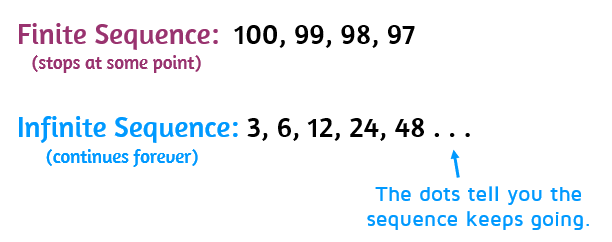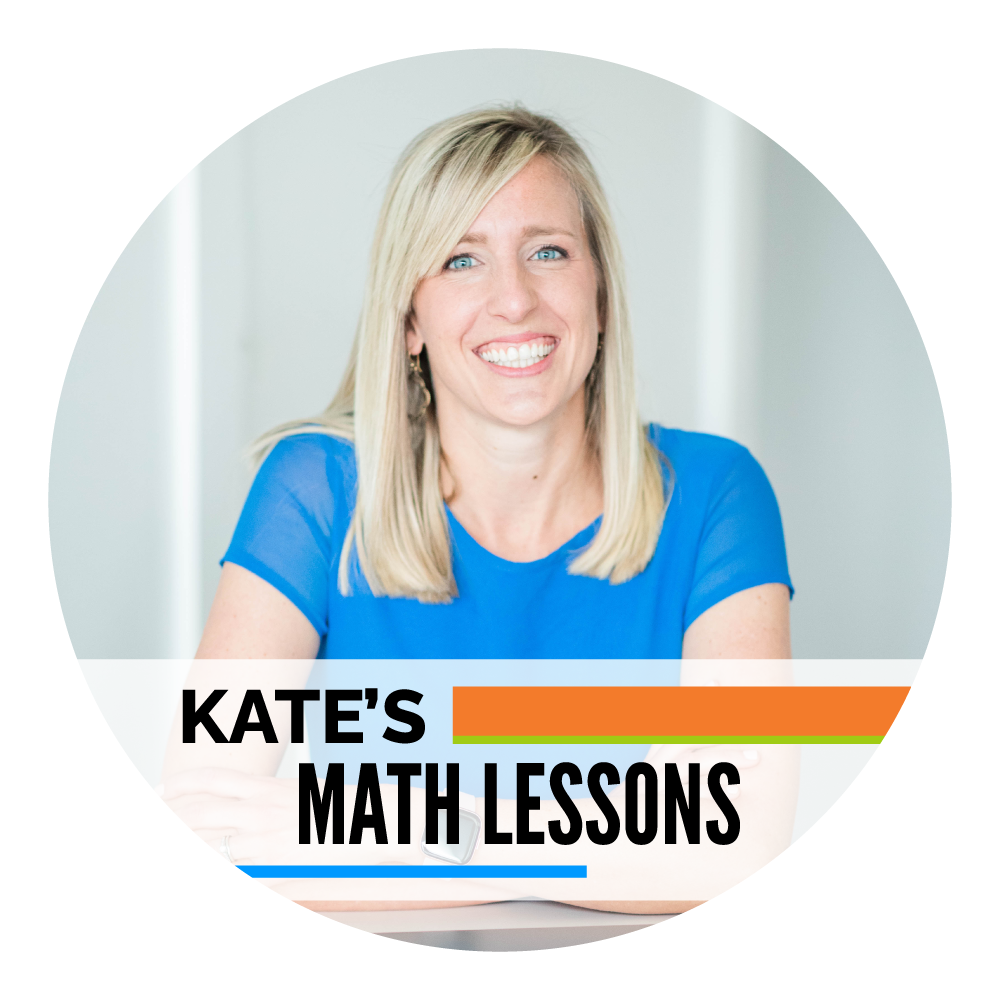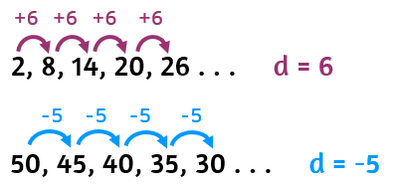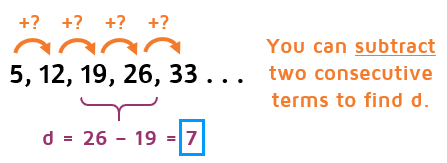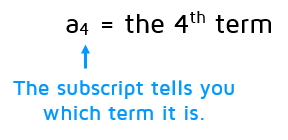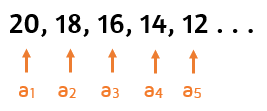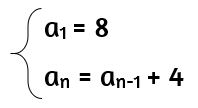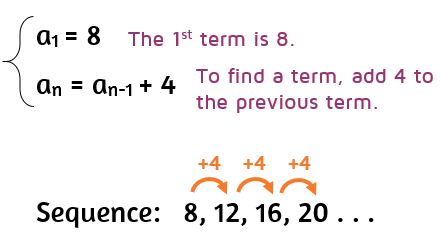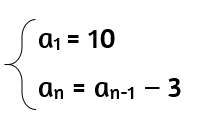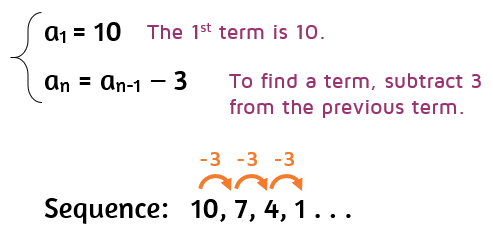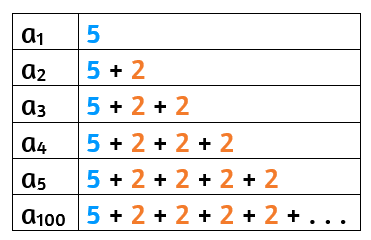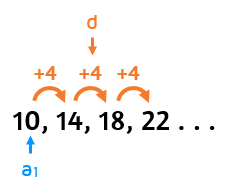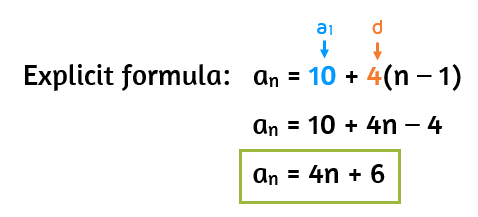|
|
Another way to describe an arithmetic sequence would be to say that the difference between consecutive terms is a constant. If you look at the difference between terms in the sequence above, you see that the difference is always 2. 18 - 16 = 2, 16-14 =2, 14-12 = 2, and 12-10 = 2.
The number that is being added each time to get to the next term is called the common difference. This is the constant difference you get between each set of consecutive terms. We use the letter d to indicate this value.
If the common difference of an arithmetic sequence is 6, that means 6 is being added each time to get to the next term in the sequence. If the common difference is -5, that means you subtract 5 each time to get to the next term (adding -5 is the same as subtracting 5).
If the common difference is positive, you know the numbers in the sequence are getting larger because you're adding a positive number each time to get to the next term. If the common difference is negative, that means the terms are getting smaller. Remember, adding a negative is the same as subtraction. For example, if d = 3 that means you add 3 each time to get to the next term. If d = -3, you subtract 3 each time.
If you're asked to find the common difference of an arithmetic sequence, that means you need to figure out the number that's being added each time to get to the next term of the sequence. Don't forget that the common difference d will be a positive number if your terms are getting larger and d will be a negative number if your terms are decreasing.
If you're not sure what number is being added or subtracted, you can always pick any two consecutive terms and subtract them to figure out the common difference.
Important Note: If you're not sure the sequence is arithmetic, you'll want to double check to make sure the difference between each set of consecutive terms is the same. If the number that's being added isn't the same number each time, it's not an arithmetic sequence.
Notation for Terms of a Sequence
You can use a subscript to indicate a term number. For sequences, we usually use the letter a and then write a small number down and to the right to indicate which term it is. For example, let's say you see an a and then a small 4 written after it. The small 4 indicates that it's the 4th term of the sequence.
Each term of a sequence can be labeled using subscripts. Here's an example of how you could label the first 5 terms of a sequence:
If you're reading these aloud, you would say "a sub 1, a sub 2, a sub 3" etc.
The "nth" Term of an Arithmetic Sequence
Sometimes you'll see the letter a and then a small subscript n written after it. This is called the "nth" term. It's a generic term and can represent any term in the sequence by just plugging in a value for n.
When sequences form patterns, it can be helpful to develop a formula that can be used for finding other terms in the sequence. Open the next tab to learn more.
Recursive Formulas
The word "recursive" has to do with something being repeated or something that reoccurs over and over again. For sequences, a recursive formula is a formula that you have to use over and over again to come up with the terms of the sequence. A recursive formula for an arithmetic sequence just tells you what to do to get to the next term. Here's an example of a recursive formula.
Example 1
Let's go through this formula piece by piece. The top line says a sub 1 is equal to 8. The small subscript 1 means it's the 1st term of the sequence. So the top line is just telling us how to start out the sequence.
The second line starts out with a sub n. Remember, this represents the "nth" term of the sequence is just a generic term. It's basically saying, "to find any term you want in the sequence, you _____." A recursive formula gives you the steps to take to find the next term in the sequence.
We know the first term of this sequence is 8. If we want to find the 2nd term, we need to plug in 2 for n (in both spots). This simplifies to the 1st term plus 4.
Remember, a recursive formula is one that you have to use over and over to get more terms of a sequence. If you want to find the 3rd term, you plug in 3 for n. If you want to find the 4th term, you plug in 4 for n and so on. You have to repeat the process over and over to continue finding more terms.
Did you notice a pattern? To find a term of the sequence, you add 4 to the previous term. If you repeat this process over and over, you generate the sequence.
Example 2
Use the recursive formula below to find the first 4 terms of the sequence.
The top line tells you that the first term is 10. The bottom line tells you that to find a term of the sequence, you subtract 3 from the previous term. This means that your sequence will start with 10, and then subtract 3 each time to get the next few terms.
Explicit Formulas
Let's say you are asked to find the 30th term of a sequence. If you have the recursive formula, you have to start with the first term and find term after term until you get to the 30th one. What a pain! Thankfully there are also explicit formulas for sequences. An explicit formula is a formula where you can find any term you want without needing to know the previous terms. Here's an example:
Example 1
With this type of formula, you can plug in any value you want for n to find the term that you want. If you want to know the 1st term, you plug in 1 for n. If you want the 30th term, you plug in 30 for n. You can find any term you want without needing to use a recursive formula over and over again.
Example 2
Find the 50th term of the sequence given below.
If this had been a recursive formula, you would have to use the formula over and over until you found the 50th term. With an explicit formula, you just plug in the value for n that you want. In this case, we want the 50th term so we plug in 50 for n and simplify.
Finding Terms of a Sequence
If you have a sequence with a pattern, you'll often be asked to find a certain term later on in the sequence. If you have an explicit formula for the sequence, you just plug in the value for n that you need. But sometimes they don't give you a formula. For example, your teacher may give you the sequence 5, 7, 9, 11 . . . and ask you to find the 20th term or the 100th term.
To do this, you could continue the pattern and list out all 20 terms or all 100 terms to find the answer.
Listing the first 20 terms wasn't too bad, but it will take a long time to list the first 100 terms. Thankfully, there's a faster way! There is a formula that you can use to find a specific term of an arithmetic sequence.
Patterns in Arithmetic Sequences
Instead of trying to list out all 100 terms of the sequence above, see if you can identify a pattern that will help you find the answer. The first term is 5 and then 2 is being added again and again to form the terms of the sequence.
Can you figure out what the 100th term will be? To find the 4th term, 2 was added 3 times. To find the 5th term, 2 was added 4 times. Once you get to the 100th term, how many times will you have added 2? You didn't add 2 for the first time, so it's one less than the term you're on. To get the 100th term, you have to add 2 a total of 99 times.
Writing an Explicit Formula
for an Arithmetic Sequence
You can use the pattern we looked at above to write an explicit formula for an arithmetic sequence. The general formula is below:
To find the nth term (any term you want), you start with the first term and add the common difference n - 1 times. For example, to find the 50th term you would take the first term and add the common difference 49 times. It's always one less because you don't add the common difference on the first time.
If you're given the first few terms of an arithmetic sequence, you just need to identify the first term and the common difference (the number being added each time). Once you plug these values in, you have an explicit formula that you can use to find any term you want.
Example 1
Write an explicit formula for the sequence 10, 14, 18, 22 . . .
In order to write the explicit formula, you need to identify the first term and the common difference. The sequence starts with 10, so that's the a sub 1. 4 is being added each time to get to the next term in the sequence, so the common difference d is 4.
In order to write the explicit formula, you need to identify the first term and the common difference. The sequence starts with 10, so that's the a sub 1. 4 is being added each time to get to the next term in the sequence, so the common difference d is 4.
Now all that's left to do is plug in 10 for the first term and 4 for d. Distribute the 4 and simplify to get the explicit formula for this sequence.
Example 2
Write an explicit form for the arithmetic sequence 7, 4, 1, -2 . . . and find the 200th term of the sequence.
To write the explicit formula, you need to identify the first term (7) and the common difference. We can see that the numbers are getting smaller, so we know that the common difference d will be a negative number.
If you're not sure what d is, you can always subtract two consecutive numbers. 4 - 7 = -3, 1 - 4 = -3, -2 - (-1) = -3, so d = -3. Remember, d is negative if the numbers are getting smaller in the sequence. Now that we have the first term and common difference, we can plug them in and simplify to get the explicit formula.
To write the explicit formula, you need to identify the first term (7) and the common difference. We can see that the numbers are getting smaller, so we know that the common difference d will be a negative number.
If you're not sure what d is, you can always subtract two consecutive numbers. 4 - 7 = -3, 1 - 4 = -3, -2 - (-1) = -3, so d = -3. Remember, d is negative if the numbers are getting smaller in the sequence. Now that we have the first term and common difference, we can plug them in and simplify to get the explicit formula.
Now that we have the explicit formula, we can find the 200th term by plugging in 200 for n.
One last note: If you're not sure if your explicit formula is correct, you can always double check. For example, we know the 3rd term of this sequence is 1. We can double check the formula by plugging in 3 for n and see if it comes out to 1. -3(3) + 10 = -9 + 10 = 1. It works!
Practice
Ready to try a few problems on your own? Click the START button below to take a practice quiz.
|
|


